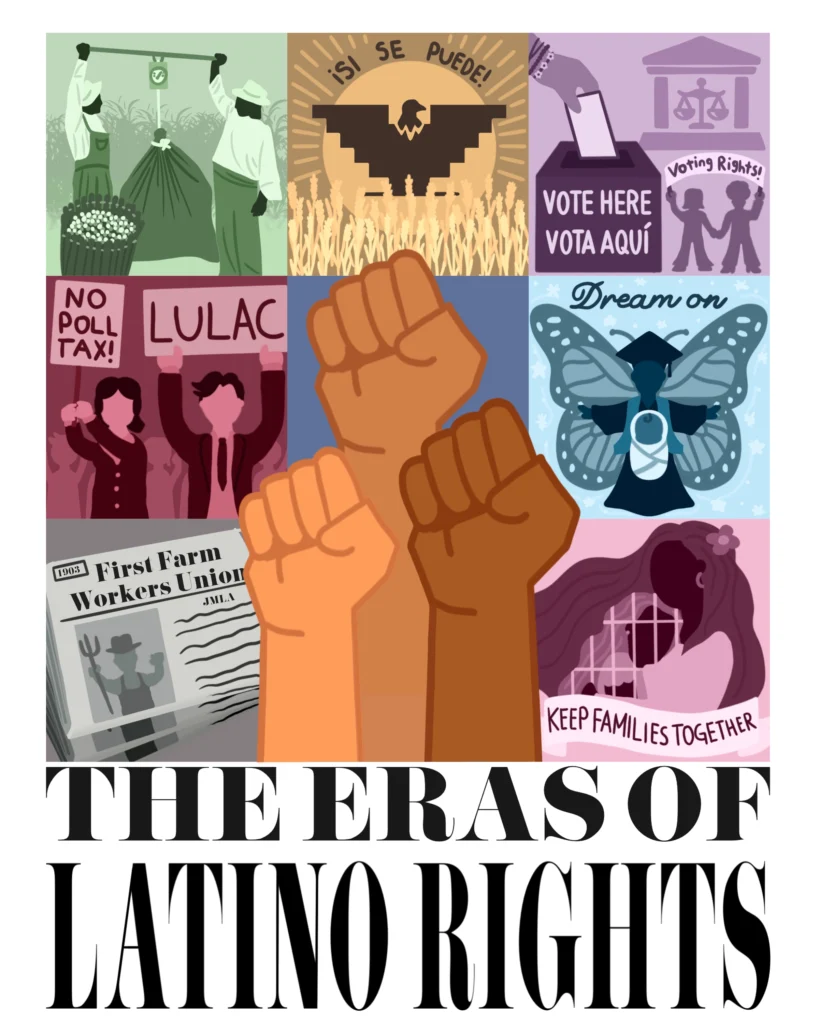
Artwork by Artist in Residence: Jasmine Mitchell
¡Celebra nuestras eras! Just like mamá Swift, Latino rights have gone through precedent-setting stages that demand commemoration. In celebrating these pivotal eras, we honor the resilience and strength embedded in the Latino rights journey:
- (Bottom left grey) We begin in 1903, with the Oxnard Strike breaking racial divides as Japanese and Mexican laborers united against oppressive working conditions. This early display of class solidarity challenged prevailing stereotypes and planted seeds for future movements towards equality.
- (Middle left red) The League of United Latin American Citizens (LULAC) was established in 1929, and continues combating discrimination, and promoting education today, standing as the longest-serving civil rights group in Latino history.
- (Top left green) In the 1940s, labor shortages led to the Bracero Program, bringing 5 million Mexican guest workers to the United States who faced low wages, difficult working conditions, and discrimination, resulting in a complex legacy of both documented and undocumented laborers.
- (Top center gold) “¡Si Se Puede!” is a slogan created by Dolores Huerta, co-founder of United Farm Workers, in support of Cesar Chavez’ nonviolent protest against a 1972 bill criminalizing the unionization of farm workers. Despite facing impossible odds, Huerta’s simple phrase became a rallying cry for the UFW, and profoundly influenced the activism landscape.
- (Top right purple) The Voting Rights Act, initially aimed at overcoming barriers for African Americans, significantly expanded by 1975 to address discrimination, particularly benefiting Latinos and other language minorities, marking a crucial milestone in the fight for voting rights.
- (Middle right blue) As a response to Congressional inaction on immigration reform, the Obama Administration introduced the Deferred Action for Childhood Arrivals (DACA), granting youths protection from deportation, and access to work permits and driver’s licenses. The introduction of DACA in 2012 provided roughly 832,881 youths the stability needed for a brighter future.
- (Bottom right pink) The Trump administration’s policy of separating families and detained children in 2018 sparked nationwide marches under the banner “Families Belong Together.” This movement, made up of 600 marches throughout the country, aimed to reunify immigrant families and highlighted the pressing need for humane and just immigration policies.
The Latino community’s history is marked by unity, defiance, and an unwavering pursuit of justice. Let these stories inspire continued advocacy for a future where all voices are heard, rights are upheld, and ¡Si Se Puede! echoes through the generations. #LatinoRights #JoltAction
Sources/For More Reading:
https://www.americanimmigrationcouncil.org/research/deferred-action-childhood-arrivals-daca-overview
https://immigrationhistory.org/item/deferred-action-for-childhood-arrivals-daca/
https://www.history.com/news/latino-voting-rights-history
https://www.americanprogress.org/article/economic-benefits-passing-dream-act/
https://guides.loc.gov/latinx-civil-rights/dream-act-daca